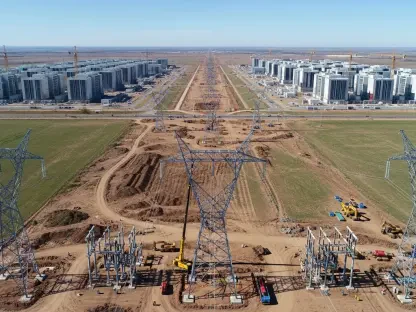The telecommunications industry is abuzz with speculation about the transformative power of Artificial Intelligence (AI), particularly the role of AI agents—autonomous systems that interact continuously with users and other machines. Could these intelligent tools drive network traffic to unprecedented, sustained levels, fundamentally altering the digital landscape? Major industry players like Cisco, Nokia, and Ericsson are sounding the alarm, predicting a dramatic surge in data flow that could strain existing infrastructure. Meanwhile, skeptics question the scale of this impact, suggesting the hype might outpace reality. This article delves into the heart of the debate, examining vendor forecasts, dissenting voices, the distinct characteristics of AI-driven traffic, and the often-overlooked security challenges. As AI integration deepens across enterprise and consumer spaces, understanding its potential to redefine network baselines becomes not just a technical concern, but a strategic imperative for the future of connectivity.
Forecasts of a Data Deluge
The notion that AI agents could trigger a seismic shift in network traffic is gaining traction among leading vendors. Cisco’s CEO, Chuck Robbins, paints a vivid picture of a future where AI tools, embedded in both workplace and home environments, maintain constant engagement rather than sporadic bursts of activity. This persistent interaction, he argues, will elevate traffic baselines far beyond current norms, requiring networks to adapt to a new reality of unrelenting demand. Such predictions are not mere speculation but are rooted in the belief that as AI becomes ubiquitous, every interaction—whether with chatbots or complex systems—will contribute to a steady data stream. The implications are profound, suggesting that network operators must rethink capacity planning to handle this continuous load, a challenge that could redefine how infrastructure investments are prioritized in the coming years.
Complementing this view, Nokia offers staggering projections, estimating that AI traffic, encompassing both direct user engagements and behind-the-scenes processes, could reach over 1,000 exabytes per month by 2033. This translates to a potential 5 to 9-fold increase in overall data flow, with uplink channels bearing significant strain as hybrid AI tools—split between on-device and cloud operations—demand far more bandwidth than currently available. Ericsson adds another layer to this forecast, spotlighting consumer video AI assistants and industrial applications like drones as key catalysts. These use cases point to a future where traffic doesn’t just spike temporarily but climbs steadily, pushing networks to their limits. The consensus among these vendors underscores a pressing need for upgrades, from backend systems to spectrum allocation, to prevent bottlenecks as AI-driven interactions become commonplace across diverse sectors.
Doubts and Divergent Views
Despite the dire warnings from vendors, not all experts are convinced that AI agents will wreak havoc on network traffic, especially on public access networks. Analyst Dean Bubley of Disruptive Analysis offers a counterpoint, suggesting that much of the anticipated AI data flow will likely be confined to corporate networks, data centers, or cloud environments, rather than flooding the infrastructure connecting homes and businesses. While he concedes there might be a slight uptick in uplink traffic for tasks involving high-bandwidth content like video or images, the impact remains speculative without solid evidence to back it up. This perspective challenges the urgency of vendor forecasts, urging a more measured approach to infrastructure planning and questioning whether the industry is preparing for a crisis that may not fully materialize in the expected form or scale.
Echoing this skepticism, discussions on professional platforms reveal a broader industry divide, with many questioning the narrative of an impending “AI traffic Armageddon.” Critics argue that vendor predictions may be influenced by commercial interests, as heightened alarm could drive sales of network solutions and upgrades. This viewpoint emphasizes the need for concrete data over projections, highlighting that much of the current discourse lacks empirical grounding. Instead of overhauling public networks prematurely, the focus might better shift to monitoring actual traffic patterns as AI adoption grows. Such a cautious stance suggests that while preparation is necessary, the scale and location of AI’s impact on traffic remain uncertain, potentially sparing access networks from the brunt of the burden as internal systems absorb much of the load.
Distinct Patterns of AI Data Flow
Beyond the debate over volume, the nature of AI traffic itself presents unique hurdles that differ from traditional data patterns. Telecom expert Azita Arvani points out that while AI-driven data doesn’t yet rival the sheer bandwidth consumed by video streaming services like Netflix, its steady and persistent flow sets it apart from the erratic, bursty nature of streaming. Agentic AI systems and constant server communications create a continuous hum of activity, challenging network operators to rethink capacity planning and rate-limiting strategies at critical points like peering edges and content delivery networks. This unrelenting pattern means that even if raw data volumes remain manageable, the consistency of AI interactions could strain systems in ways that intermittent spikes do not, requiring innovative approaches to traffic management.
Further evidence of this trend emerges from early indicators, such as data from Cloudflare showing a noticeable rise in activity from AI crawlers and agents. This suggests that the groundwork for a pervasive AI traffic presence is already being laid, even if it hasn’t reached critical mass. The implications extend beyond simply adding more bandwidth; networks must evolve to handle this constant data exchange with smarter monitoring and telemetry tools to prevent bottlenecks at key junctures. Unlike the predictable surges tied to streaming events or downloads, AI’s steady demand could reshape how resources are allocated, pushing for a more dynamic infrastructure capable of adapting to a baseline that never truly dips. This shift underscores that managing AI traffic isn’t just about scale, but about understanding and accommodating its unique behavioral footprint.
Security: The Hidden Strain of AI Interactions
While much of the conversation centers on traffic volume, a more immediate concern looms in the realm of network security as AI agents proliferate. The surge in machine-to-machine communications driven by these systems introduces countless points of vulnerability, where each interaction or data hop becomes a potential entry for threats. Arvani emphasizes the critical need for robust safeguards, including service identity verification, short-lived credentials, and micro-segmentation to isolate and protect network segments. Additionally, maintaining auditable, tamper-evident records is essential to track and secure these exchanges. The complexity of securing automated interactions suggests that even if traffic levels remain within capacity, the effort to protect against breaches could overwhelm existing systems, presenting a challenge as daunting as any data surge.
This security dimension adds a layer of urgency that transcends mere bandwidth concerns, as the stakes of failure are high in an increasingly automated digital ecosystem. Networks must not only scale to accommodate AI-driven interactions but also fortify against the risks they introduce, a task that demands significant investment in technology and expertise. Unlike capacity issues, which can often be addressed with incremental upgrades, security requires a proactive, comprehensive overhaul to ensure that every automated exchange is verified and protected. As AI agents become integral to both consumer and industrial applications, the focus must shift toward building resilient systems that prioritize safety alongside performance, recognizing that the true cost of AI integration may lie in safeguarding the vast web of connections it creates.
Navigating the Uncertain Future
Reflecting on the discourse, it becomes evident that the telecommunications sector grapples with a delicate balance between proactive readiness and cautious restraint when addressing AI’s potential to redefine network traffic. Vendors have championed aggressive investments to brace for predicted surges, painting vivid scenarios of relentless data flows driven by autonomous agents. Skeptics, however, temper these forecasts, pointing to insufficient evidence and suggesting that internal systems bear much of the load. Meanwhile, insights into AI traffic’s persistent nature and the pressing need for enhanced security underscore that the challenge is multifaceted. Moving forward, the industry must prioritize strategic planning that not only boosts capacity but also integrates intelligent management and robust protective measures. By focusing on real-time data and adaptive solutions, stakeholders can better prepare for the evolving demands of an AI-centric landscape, ensuring networks remain both scalable and secure.









